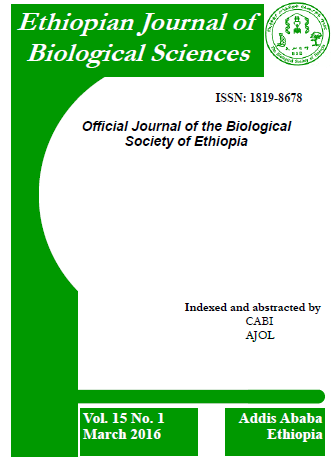POPULATION SIZE AND STRUCTURE OF BEISA ORYX AND ITS HABITAT OVERLAP WITH SYMPATRIC SPECIES IN ALLEDEGHI WILDLIFE RESERVE, NE ETHIOPIA
Abstract
This study was undertaken in Alledeghi Wildlife Reserve, NE Ethiopia, to determine the current population size and structure of Beisa oryx [Oryx beisa (Linn. 1758)] and to examine its habitat overlap with two sympatric ungulate species: Soemmering’s gazelle [Gazella soemmeringi (Cretzschmar 1828)] and gerenuk [Litocranius walleri (Brooke 1879)]. Wet and dry season wildlife surveys were undertaken in September 2015 and January 16 along 12 line transects in each of three major habitat types, grassland wooded grassland and bushland. The results showed that estimated population of Beisa oryx in the reserve was 1119 ± 7.8, 58 ± 1 and 590 ± 7 during the wet season, dry season and pooled seasons, respectively. This population was female dominated during both seasons; males to females ratio remained 1:1.8. However, there was a marked seasonal variation in group sizes of the species: ranging from 1 to 5 and from 4 to 26 individuals in the dry and wet seasons, respectively. Considering habitat type, greater mean group size of oryx was recorded in the wooded grassland habitat than the other two habitat types. Beisa oryx showed stronger preference for wooded grassland habitat during wet season, but for bushland during dry season, possibly implying that, dependent on season, different habitats provide varying level of importance. The minimum habitat overlap among the ungulates was 35% during dry season between oryx and gazelle and maximum was 85% during wet season between oryx and gerenuk. The study has provided valuable information that would help conservation management efforts.
Downloads
References
Almaz Tadesse (2009). Sustaining the Alledeghi Grassland of Ethiopia: Influences of Pastoralism and Vegetation Change. Ph.D. dissertation, Utah State University, Logan, Utah.
Barker, N. (2005). The Effect of Species Associations on the Diversity and Coexistence of African Ungulates. University of Toronto, Toronto, Canada.
Befekadu Refera and Afework Bekele (2004). Population status and structure of mountain nyala in the Bale Mountains National Park, Ethiopia. Afr. J. Ecol. 42: 1–7.
Burnham, K.P., Anderson, D.R. and Laake, J. L. (1980). Estimation of density from line transect sampling of biological populations. Wildlife Monogr. 72: 1–202.
Cherie Enawgaw (1999). The Status of Mammals, Ostrich and Crocodile in Omo National Park. Unpublished report, Ethiopian Wildlife Conservation Organization, Addis Ababa.
Cherie Enawgaw (2004). Population Status and Distribution of Artiodactyls in Awash National Park with Special Reference to Beisa Oryx (Oryx beisa beisa). M.Sc. Thesis, Addis Ababa University, Addis Ababa.
More inside the PDF
